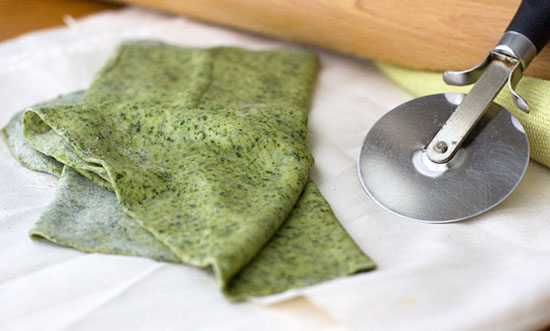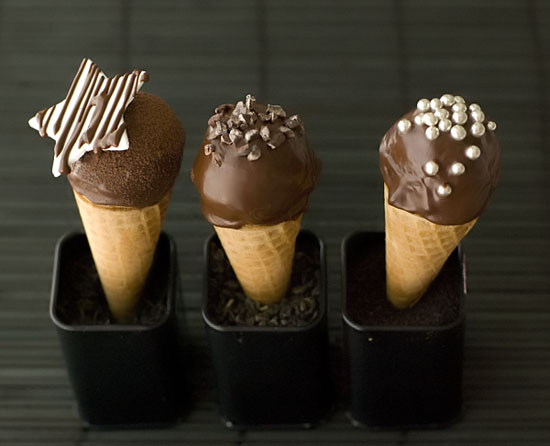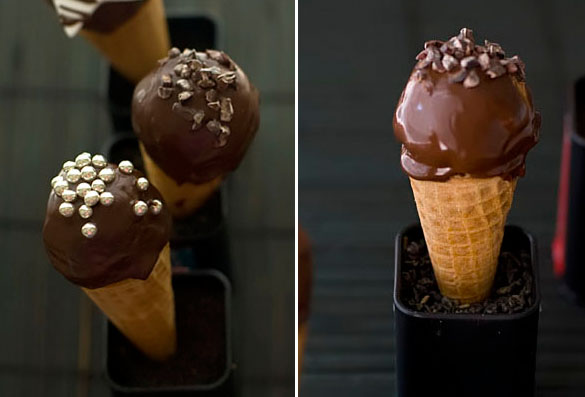Daring Bakers Challenge : Cheesecake

The April 2009 challenge is hosted by Jenny from Jenny Bakes. She has chosen Abbey’s Infamous Cheesecake as the challenge.
I guess I’ll start by being completely honest and saying that I’m not a huge fan of cheesecake. The only cheesecake I would ever pay money for, comes from Yellow Bistro in Potts Point. Other than that, I’ll eat it if placed in front of me (because I’ll try anything at least once), but only with great dismay at the thought of there being so many other delicious things I could be putting on my hips instead.

The idea for the Brie cheesecake came from a chance conversation with Lorraine about cheesecakes. Somehow the word “cheeseplate cheesecake” was thrown out there and at some point we even contemplated collaborating to create an entire platter of cheeseplate-themed cheesecakes. Unfortunately, time and busy lives prevented this from occuring.
I know it is a little cliched that I have decided to present this as a ‘deconstructed’ cheesecake. The idea has been done to death before, but I thought the presentation would really suit the cheeseplate theme. The Brie flavour in this cheesecake is actually quite subtle. If you eat it alone, you will find that the cream cheese and white chocolate flavours are dominant, while the Brie-ness is only more apparent at the finish. However, the flavour really comes to the fore when you take a bite with the accompanying candied (and slightly salty) celery.
Brie and white chocolate cheesecake, pecans and celery :
(This recipe is a combination of Abbey’s Infamous Cheesecake, and a Brie-white chocolate cheesecake from Pure Chocolate by Fran Biglow)
Brie and white chocolate cheesecake :
270g cream cheese
65g caster sugar
40g white chocolate
2 eggs
135g triple cream brie (weight after rind has been removed)
1/4 teaspoon vanilla extract
Preheat the oven to 150’C.
Melt the white chocolate in the microwave in a double boiler. Set aside to cool.
In a mixer with the paddle attachment, beat the cream cheese on medium-high speed until smooth, about 3 minutes. Transfer the cheese to a separate bowl and set aside.
In the same mixing bowl using the paddle attachment, beat the Brie until completely smooth. With the machine still going, gradually add the cream cheese to the Brie, scraping down the sides of the bowl. Add the sugar, then the eggs, one at a time. Pour in the melted white chocolate and continue to mix until well blended and smooth. Pour into a baking dish and bake it in a waterbath for about 55 minutes (it may take longer depending on the size of your dish). The cheesecake should have a slight jiggle to it. Remove from the oven and allow to cool completely in the waterbath, then cover and put in the fridge to chill.
Pecan ‘crust’ :
110g plain flour
3/4 teaspoon baking powder
70g unsalted butter
65g light brown sugar
30g pecans, roughly chopped
Combine the flour, baking powder in a bowl. Rub in the butter then add the brown sugar and pecans. Scatter this mixture on a lined tray and bake at 170’C for about 35 minutes until browned. Stir the mixture occasionally during the baking time, to ensure even cooking.
Celery confit :
(based on recipe in Wild Sweets by Dominique and Cindy Duby)
100g celery stalks
150ml sugar syrup
50ml water
1/4 teaspoon sea salt
1/2 teaspoon yuzu (or lemon) juice
Trim stalks and remove filaments with a paring knife. Using a potato peeler, shave long vertical strips the length of the stalk.
Bring the syrup, water, salt and yuzu to a boil. Taste and adjust with more salt if necessary. The salt is important to balance the sweetness. Add the celery and cook until soft and translucent, about 3 to 5 minutes. Remove from syrup and chill until required.
To assemble :
Spoon the baked cheesecake mixture into a food processor. Process briefly until smooth.
Place a teaspoonful of cranberry relish or jam on the plate (this is optional). Scatter the pecan crust over this. Arrange a spoonful of cheesecake mixture on top of the crust. Serve alongside the candied celery strips.
Tags: cheesecake, Daring Bakers, pecans





